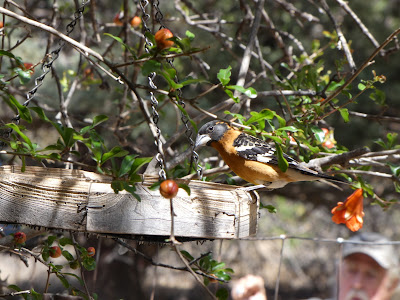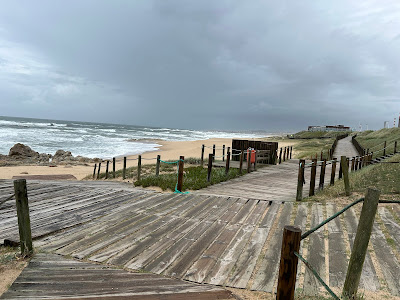 |
| Portuguese Coastal |
If you hike in Portugal in the early spring, don’t forget to bring some serious rain gear.
Or that’s one of the lessons I learned this April while hiking the Camino Portuguese. It rained for the first two days of the hike, and it came down hard at times.
A little rain in the spring while hiking is to be expected, a routine part of the outdoor experience. But this Portuguese rain morphed into one of the most powerful storms I’ve ever been in.
On day one, out of Porto, while I was hiking north on the coastal route, the wind and rain were off-and-on, persistent but manageable. On day two, though, after I switched to the central route, the early-morning rain was torrential. The 75-kph wind gusts broke my umbrella and the wind blew the rain horizontally into the hood of my raincoat, drenching me inside the jacket. It was 50 degrees that morning, so I was not only miserably wet but also freezing and even felt like I might be on the verge of hypothermia.
Fortunately, after sloshing onward through the ankle-deep puddles on the remote countryside road north of Vilarinho, I made it to a tiny town. There, just as I was approaching, a woman was opening the only bar for miles in each direction. What a relief. I entered, had 2 cups of cafe con leche (coffee with milk) and a grilled ham-and-cheese sandwich.
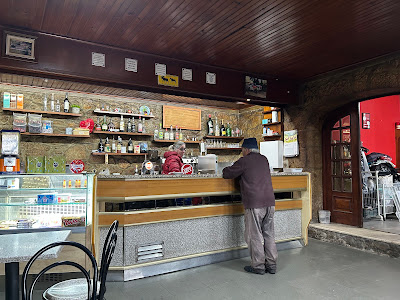 |
| Camino angel tending the bar |
With heavy rains forecast to continue through much of the day, I hit the reset button. At my request, the lady in the bar called the local cab driver, and he gave me a ride to Ponte de Lima, 60 km to the north. There I waited out the storm sipping vino tinto (red wine) and cafe con leche in a posh seafood restaurant across the cobbled road from the town’s excellent albergue.
The weather was beautiful throughout most of the remaining 17 days of my trek ( just a day or two of light, scattered showers), and it didn’t start raining seriously again until the evening of April 10, after I had already safely arrived in Spain’s Santiago de Compostela.
It is said that camino provides to protect peregrinos, and arriving at this bar just as it was opening during the height of the storm is an example of the kind of good fortune I have experienced during my camino walks thus far. But I won’t press my luck. The next time I hike a camino in the spring, I’ll bring a poncho to back up the raincoat, just in case.
During this spring’s adventure, I hiked on two of the Caminos de Santiago—the Portuguese and the Invierno. More than a dozen of these ancient Catholic pilgrimage routes cross Europe and Spain and converge on the majestic cathedral in Santiago de Compostela, Spain. The remains of Santiago (Saint James) are said to be buried in a tomb in the cathedral.
Peregrinos, or pilgrims, have been hiking the camino routes for many centuries to seek forgiveness of their sins and more recently also for other purposes. Some devout Catholics believe that completing one of the routes guarantees them a spot in heaven.
I was originally hoping to hike the section of the Portuguese camino all the way between Porto and Santiago this year. But I ended up restarting the trek in Point de Lima, PT, to get back on schedule after being delayed by the two days of stormy weather.
 |
| Damp footpath |
After I completed the 152-km section of the Portuguese camino, I took a bus from Santiago to Ponferrada, Spain, and then hiked the 253-km Camino Invierno back to the cathedral.
Of the two Caminos, I preferred the Invierno but think the Portuguese route would be a far better choice for less-experienced trekkers. The Invierno is much less-traveled than the Portuguese, has far fewer services and goes through more remote territory. There is also less English spoken on the Invierno than on the Portuguese.
That the Invierno is less-traveled than the Portuguese could be a bit of an understatement. Of the half million peregrinos who hiked caminos last year, 170,254, or 34%, received compostelas (certificates of completion) for hiking at least the last 100 km of one of the two main Portuguese camino routes, according to the Pilgrim’s Reception Office, the organization that issues the certificates in Santiago. The office said that only 2,869, or less than 1/2 of one percent of peregrinos received compostelas for hiking the Invierno.
Practically, this meant that while hiking the Portuguese camino, I ran into dozens of other peregrinos each day, on the trail and in the albergues. On the Invierno, I sometimes didn’t see another peregrino all day, and on several occasions, had only one other albergue roommate at night.
 |
| No-pack look on the Portuguese |
One difference I noticed between the pilgrims hiking the Portuguese and Invierno caminos is that many of the hikers on the Portuguese were carrying only a few daily essentials in small daypacks and using shuttle services to transport most of their belongings between stops. The handful of other Invierno hikers I met all seemed to be carrying most of their own luggage in their backpacks.
Overall, I hiked an average of 15 miles a day during this adventure. I often started hiking before madrugada (dawn) to get to my destination before 4 p.m., when many restaurants close for siesta.
Many of the restaurants in Spain reopen for dinner at 8 or 9 p.m. but that’s past my bedtime during these adventures because I need at least 10 hours of sleep a night to continue hiking day-after-day like this.
One of the toughest but most beautiful hikes on the Invierno for me was the 19.7-mile trek through the hilly countryside between Montforte de Lemos and Chantada. This section of the camino includes a lot of what the Spanish refer to as “romper piernas” (leg breakers or steep sustained climbs). But the weather was perfect—sunny, cool and breezy—and the views were spectacular. Buen camino.
 |
| Canadian family on the Portuguese |
 |
| Sunrise over vineyard |
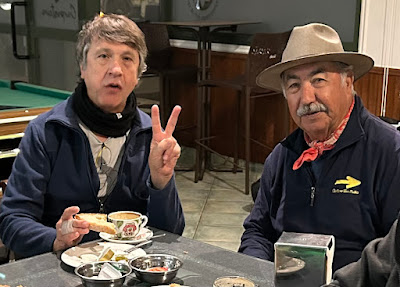 |
| Traveling companions Jose, 62, and Salvador, 78 |
 |
| Templar Castle Ponferrada |
 |
| Huge trout in this river |
 |
| Castle overlooking Villa Viaje |
 |
| Fresh sardines in Porto |
 |
| Peregrino luggage for the shuttle service |
 |
| Another predawn start |
 |
| Frank, Spanish peregrino, enjoying cerveza breakfast |
 |
| Camino folk art |
 |
| River Sil |
 |
| Lots of storks |
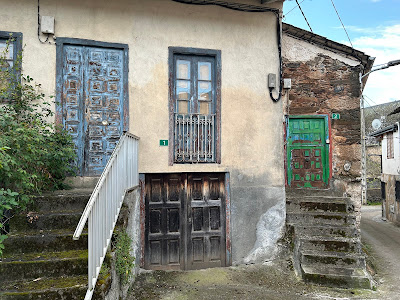 |
| Great doors in Spain |
 |
| Manuel, legendary proprietor of Sobradelo Bar Mar |
 |
| The yellow arrows mark the way |
 |
| The gang at Casa Leiras in Dornelas |
 |
| Santiago cathedral |
 |
| I always light a candle during my visits |
 |
| Pilgrim's mass |





